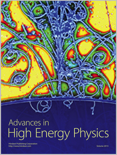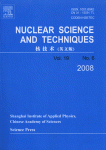
PHYSICS OF ATOMIC NUCLEI
metrics 2024
Driving Innovation in High-Energy Physics
Introduction
PHYSICS OF ATOMIC NUCLEI is a distinguished journal dedicated to advancing the understanding of nuclear and particle physics, published by PLEIADES PUBLISHING INC. With its ISSN 1063-7788 and E-ISSN 1562-692X, this journal serves as a vital resource for researchers, professionals, and students in the fields of atomic and molecular physics, as well as high-energy physics. The journal has been actively contributing to the scientific community since its inception in 1996 and continues to publish valuable findings through 2024. Despite its current standing in the Q4 category for both Atomic and Molecular Physics, and Nuclear and High Energy Physics, there is an abundance of potential for growth and impact in these disciplines, as evidenced by its placement in the Scopus rankings. While the journal does not currently offer open access, it remains committed to disseminating quality research that informs and engages the scientific community. Explore PHYSICS OF ATOMIC NUCLEI to stay at the forefront of nuclear physics research and contribute to the dialogue in this critical area of study.
Metrics 2024
 0.19
0.19 0.30
0.30 0.40
0.40 50
50Metrics History
Rank 2024
Scopus
IF (Web Of Science)
JCI (Web Of Science)
Quartile History
Similar Journals

Advances in High Energy Physics
Exploring the Frontiers of Nuclear and High Energy PhysicsAdvances in High Energy Physics, published by HINDAWI LTD, is a premier open-access journal dedicated to the progressive field of Nuclear and High Energy Physics. With an ISSN of 1687-7357 and an E-ISSN of 1687-7365, this journal has been at the forefront of scientific discourse in high energy physics since its inception in 2007. The journal is notable for its impact within the community, currently holding a Q2 ranking in 2023 and positioned at #36 out of 87 in its category according to Scopus, highlighting its significant contribution to ongoing research and advancement in the field. Its accessible nature enables researchers, professionals, and students to engage with cutting-edge findings that shape our understanding of the universe. Spanning publications from 2010 through 2024, Advances in High Energy Physics serves as an invaluable resource for those looking to stay informed about the latest developments and methodologies in high energy physics across the globe.

Physics of Particles and Nuclei Letters
Charting New Territories in Nuclear ResearchPhysics of Particles and Nuclei Letters, published by PLEIADES PUBLISHING INC, serves as a pivotal platform for the dissemination of cutting-edge research in the domains of particle and nuclear physics. With an ISSN of 1547-4771 and an E-ISSN of 1531-8567, this journal has been actively contributing to the scientific community since its inception in 2006 and continues to be influential, with a convergence period extending to 2024. While its open access options are limited, the journal is recognized for its rigorous peer-review process and commitment to quality, as reflected in its Scopus rankings across multiple categories, including a Q3 in Nuclear and High Energy Physics and Radiation in 2023. The journal is positioned to be a vital resource for researchers aiming to bridge theoretical understanding with practical applications in these highly specialized fields, fostering advances that resonate within atomic and molecular physics, radiology, and beyond. Its relevance continues to grow as the global scientific community seeks innovative solutions to complex problems in modern physics.

PHYSICAL REVIEW C
Igniting Innovation in Subatomic ResearchPHYSICAL REVIEW C is an esteemed journal published by the American Physical Society, dedicated to advancing knowledge in the fields of nuclear and high-energy physics. With a proud ISSN of 2469-9985 and an E-ISSN of 2469-9993, it has established itself as a leading journal, currently ranked in the Q1 category for its field in 2023, positioning itself in the top tier of scholarly publications. Based in the heart of the United States, at One Physics Ellipse, College Park, MD, PHYSICAL REVIEW C is known for its rigorous peer-review process and is a vital platform for researchers to share their pioneering findings. As part of a prestigious lineup backed by an impressive impact factor, this journal garners significant attention, reflected in its Scopus ranking as #18 out of 87 in the Nuclear and High Energy Physics category, placing it within the 79th percentile. While it currently does not offer open access options, it remains an essential resource for professionals and students seeking to deepen their understanding of nuclear interactions, reaction dynamics, and the fundamental principles governing subatomic particles. The convergence of innovative research from 2016 to 2024 makes it a timely reservoir for groundbreaking studies, thus reinforcing its importance in the scientific community.

Radiation Detection Technology and Methods
Pioneering Research for Enhanced Energy SecurityRadiation Detection Technology and Methods is a prominent academic journal published by Springer Singapore Pte Ltd, dedicated to advancing the field of nuclear and high-energy physics, as well as nuclear energy and engineering. Established in 2017, this journal provides a platform for the dissemination of pioneering research and innovative methodologies in radiation detection technology. As of 2023, it holds a commendable Q2 ranking in both the categories of Nuclear and High Energy Physics and Nuclear Energy and Engineering, underscoring its significance in fostering scholarly discourse within these vital fields. With ISSN 2509-9930 and E-ISSN 2509-9949, the journal aims to cater to a diverse audience of researchers, professionals, and students, emphasizing open access to knowledge. The journal's contributions are particularly crucial for those engaged in the development of safer and more efficient radiation detection techniques, ultimately bridging the gap between theory and practical applications in energy security and health physics. For researchers seeking a dedicated outlet for their work, Radiation Detection Technology and Methods represents an invaluable resource and an opportunity to influence the future of radiation science.

Atoms
Innovating knowledge in condensed matter and high-energy physics.Atoms is a distinguished open-access journal published by MDPI since 2013, dedicated to the fields of Atomic and Molecular Physics, Condensed Matter Physics, and Nuclear and High Energy Physics. With its E-ISSN of 2218-2004, the journal is based in Switzerland and has rapidly established itself as a noteworthy platform for disseminating innovative research and developments in atomic-scale physics. As reflected in its 2023 Scopus ranking, Atoms holds a respectable position within its field, with quartile rankings in the third tier across all its main categories. The journal's commitment to open access fosters a broader reach and collaboration within the scientific community, making it an essential resource for researchers, professionals, and students alike. The ongoing convergence of trends and research from 2013 to 2024 highlights Atoms' role in advancing knowledge and facilitating dialogue in crucial areas of physics.

Annual Review of Nuclear and Particle Science
Illuminating the Complexities of the Subatomic WorldAnnual Review of Nuclear and Particle Science is a prestigious journal published by Annual Reviews, focused on the fields of nuclear and high-energy physics. With an impressive impact factor that reflects its authority and influence—ranked Q1 in its category and holding a commendable Scopus rank of #2 out of 87, placing it in the 98th percentile—the journal serves as an essential resource for researchers, professionals, and advanced students alike. Covering pivotal developments and comprehensive reviews in nuclear and particle physics since its inception in 1978, this journal offers unparalleled insights into cutting-edge research and theoretical advancements. While it is not open access, the value of its scholarly content is evidenced by its rigorous peer-review process and its role in shaping contemporary discourse within the scientific community. With contributions from leading experts and a commitment to disseminating foundational and emerging theories, the Annual Review of Nuclear and Particle Science is indispensable for those seeking a deep understanding of the complexities in these dynamic fields.

Problems of Atomic Science and Technology
Unveiling the Future of Nuclear Engineering.Problems of Atomic Science and Technology is a leading journal in the realm of nuclear physics and technology, published by the esteemed Kharkov Institute of Physics and Technology. With an ISSN of 1562-6016, this journal is dedicated to disseminating high-quality research and advancements in atomic sciences, contributing significantly to both academic and practical applications in the field. Although not an open access publication, it ensures rigorous peer review standards to maintain the integrity and relevance of cited works. The journal seeks to provide a vital platform for researchers, professionals, and students who are engaged in the exploration of atomic phenomena, nuclear engineering, and associated technologies. Published from Kharkov, Ukraine, the journal also serves as a bridge for international collaboration and innovation, making it indispensable for anyone looking to stay at the forefront of atomic science research.

ATOMIC DATA AND NUCLEAR DATA TABLES
Navigating the complexities of atomic and nuclear phenomena.ATOMIC DATA AND NUCLEAR DATA TABLES, published by Academic Press Inc Elsevier Science, is a leading journal in the fields of atomic and molecular physics, as well as nuclear and high energy physics. With an ISSN of 0092-640X and an E-ISSN of 1090-2090, this esteemed journal has been providing comprehensive data tables and significant research insights since its establishment in 1969. Spanning until 2024, it continues to serve as an invaluable resource for researchers and professionals aiming to deepen their understanding of atomic interactions and nuclear processes. Holding a commendable Q2 ranking in both relevant categories, it is recognized for its impact, reflected in Scopus rankings, where it ranks 25th out of 87 in Nuclear and High Energy Physics, and 87th out of 224 in Atomic and Molecular Physics. While it does not offer open access, the journal remains a crucial repository for high-quality data essential for scientific endeavors and advancements in these complex fields.

Nuclear Science and Techniques
Connecting Researchers to the Heart of Nuclear InnovationNuclear Science and Techniques is a distinguished peer-reviewed journal published by Springer Singapore Pte Ltd, dedicated to advancing the fields of nuclear science and engineering. With an impressive impact factor reflected in its 2023 quartile rankings—Q2 in Nuclear and High Energy Physics and Q1 in Nuclear Energy and Engineering—the journal serves as a vital resource for researchers, professionals, and students alike. Covering a breadth of topics from nuclear physics to energy applications, it offers a platform for innovative research and developments in the nuclear domain. The journal, indexed under ISSN 1001-8042 and E-ISSN 2210-3147, aims to foster scientific exchange and collaboration within the community by publishing high-quality articles that contribute significantly to the field. Committed to maintaining an open-access ethos, it enhances visibility and accessibility of critical knowledge, making it an essential source for current insights and trends in nuclear science.

Nuclear Physics and Atomic Energy
Empowering scientists through open-access innovation.Nuclear Physics and Atomic Energy is a reputable open-access journal that focuses on the fields of nuclear physics and high-energy physics, providing a forum for researchers, professionals, and students to share their findings and advancements. Published by the Institute of Nuclear Research, National Academy of Sciences of Ukraine, this journal has been committed to disseminating knowledge since its inception in 2006, ensuring that scientific advancements remain accessible to a global audience. With an ISSN of 1818-331X and an E-ISSN of 2074-0565, the journal features a diverse array of articles that span the continued exploration and application of nuclear phenomena. Although currently categorized in the Q4 quartile for Nuclear and High Energy Physics in 2023, the journal is steadily working towards increasing its impact and engagement within the academic community. With a Scopus rank of #74 out of 87 in its category, it serves as a valuable resource for advancing crucial research in a vital scientific area. Researchers are encouraged to contribute their innovative studies to foster collaboration and knowledge sharing in this dynamic field.